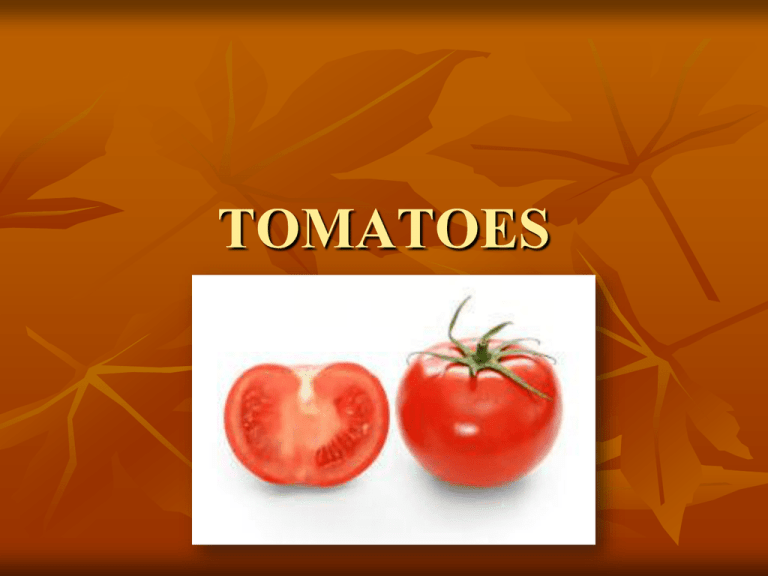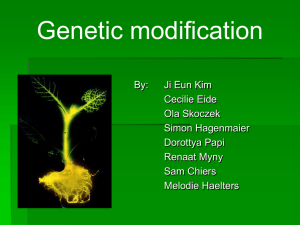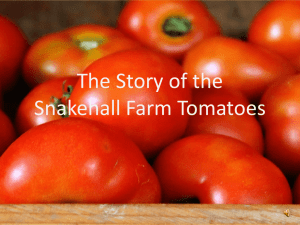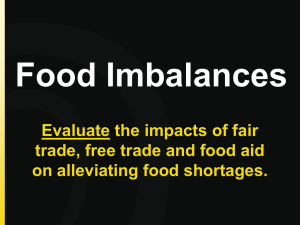Tomatoes
advertisement

TOMATOES tomatoes Tomatoes herbaceous perennials Lycopersicon esculentum or Solanum lycopersicum part of the Solanaceous (nightshade) family same family as potatoes and eggplants Tomatoes were first domesticated in Mexico Tomatoes and tomato products are a large part of the vegetables consumed by Americans US is the second largest producer of tomatoes Tomatoes are a good source of: • vitamin C • vitamin A (as beta-carotene) • protein (in seeds) Phytochemicals in tomatoes p. coumaric acid lycopene chlorogenic acid beta-carotene flavonoids quercetin Lycopene C40H56 Lycopene The most abundant pigment in ripe tomatoes 80 – 90% of all pigments Most tomatoes contain 3 to 5 mg/100g raw material Located in chloroplast of fruit and thylakoid membrane of photosynthetic pigment-protein complexes Lycopene Exists as trans-isomer in nature Can isomerize to mono or poly-cis form from: Heat Light Certain chemical reactions Most efficient singlet oxygen and ROS scavenger of known carotenoids Lycopene: Heath Benefits Good antioxidant activity due to extended system of conjugated double bonds Has ability to trap peroxyl radicals May reduce threat of CVD by: Reduction of inflammation Inhibition of cholesterol synthesis Lycopene: Health Benefits Antioxidant properties show anticancer effects by : Preventing the growth of prostate cancer cells Inhibiting anti-androgen Decreases endogenous DNA strand breakages in lymphocytes of humans Lycopene: Health Benefits Increased serum lycopene levels have shown inversely correlated relationship with many types of cancer, such as: Oral cavity Esophagus Stomach Colon Rectal Pancreas Bladder Breast Lycopene: Bioavailability Highly variable and affected by several factors: Molecular linkage Food matrix the lycopene is part of, and particle size of lycopene containing food Amount of lycopene consumed in meal Levels of dietary fiber, fats, proteins and other carotenoids consumed at the same time Lycopene: Bioavailability More bioavailable in cooked, finley grated or processed form of tomato products Due to the release of lycopene from the tomato tissue matrix and disruption of plant cell walls and lycopene-protein complexes Heat in processing can convert trans to cis Cis-isomer less likely to aggregate and crystalize. Cis-isomer more soluble in bile acids and other lipophilic solutions. Cis-isomer more easily transported in tissue and cell matrices. Lycopene: Bioavailability Lycopene absorption hindered when ingested with dietary fiber or high-methoxyl petin. Due to the promotion of a highly-viscous condition in the dietary tract. Chlorogenic Acid Acts as an antioxidant in plants and protects against degenerative, age-related diseases in animals when supplied in their diet. Is the major soluble phenolic in Solanaceous species such as potato, tomato and eggplant. Also accumulates to substantial levels in apples, pears, plums and coffee. Chlorogenic Acid Can limit low-density lipid (LDL) oxidation, the major determinant of the initial events in atherosclerosis Removes particularly toxic reactive species by scavenging alkylperoxyl radicals and may prevent carcinogenesis by reducing the DNA damage they cause Chlorogenic Acid High bioavailability Antioxidant potential of CGA is probably more accessible than that of many flavonoids Can be absorbed directly by the small intestine but most CGA is absorbed in the large intestine by esterases of the gut microflora to release caffeic acid Research in Tomatoes Gene silencing proved HQT to be the principal route for accumulation of CGA in solanaceous species. Over expression of HQT in tomato caused plants to accumulate higher levels of CGA Showed improved antioxidant capacity and resistance to infection by a bacterial pathogen. Beta-carotene Orange colored member of the carotenoid family. Fat soluble compound found in many fruits and vegetables. Second most abundant carotenoid in tomatoes after lycopene. Dimer of vitamin-A Beta-carotene: Health benefits Conversion into retinol by the body. Studies relating beta-carotene with reduction in macular degeneration, anti-aging, cataract, asthama, heart and AIDS have been done in past. Natural antioxidant free radical quenching, singlet oxygen scavenging and lipid antioxidant capacity Potential anticancer agent (?) Beta-carotene: Health benefits Supplemental beta-carotene have been shown to increase lung cancer incidents among smokers. (Omenn et al, 1996 and, alpha-tocopherol beta-carotene study, 1994) Synthetic and all-Trans beta-carotene have been predicted to cause increased risk of cancer. (BenAmotz et al, 1998) A natural diet rich in carotenoids may actually reduce the risk of lung or other cancer. (Holick et al, 2002) Beta-carotene: Tomatoes Beta-carotene accounts for 20-35% of total carotenoids in tomatoes. (Kmiecik & Liciewska, 2000) Some of the factors that may effect the betacarotene content in tomato are type of cultivars, stage of maturation of tomato fruit, method of processing storage Transgenic tomatoes Beta-carotene: Effect of cultivar type In a study done on 18 different variety of tomato beta carotene content ranged from 0.28 mg/100gm (1447) to 1.00 mg/100gm (Poly 20) among the different lines. Reporting of higher beta-carotene in tomato was done by Kmiecik & Liciewska (2000) in a study of six different cultivars at an average of 1.31 mg/100g. Significant difference among cultivars was noticed. Source: Frusciante et al, 2007 ) Beta-carotene: Stage of growth of fruit Quantify the carotenoid pigments during the growth of tomato fruit after flowering was done by Nobuyuki & Friedman (2003) . Beta-carotene (1.2±0.1 g/100g) was only detected after the 50th day of flowering. Beta-carotene: Effect of processing Lin & Chen (2005) worked on evaluating effect of three different heat treatments tomatoes on the final beta-carotene. Hot break screened tomato juice was subjected to 90C for 5 min prior to canning, Boiled in water at 100C for 30 min after canning and HTST done at 1210C for 40 sec before canning. No significant difference was observed. Beta-carotene: Effect of processing Amount of beta-carotene decreased continuously over time when stored at 30±20C without preservative, the tomato soup with sodium benzoate showed significantly reduced losses. Beta-carotene, mg/100gm 14 12 No Preservative 10 Sodium Benzoate 8 6 Percent decrease (No Preservative) 4 Percent decrease (Sodium Benzoate) 2 0 0 15 30 45 60 Storage period, days Source: Vashista, A. et al 2003. Figure generated using data presented (Vashista et al, 2003) Beta-carotene content in Micra RS cultivar of tomato reduced from 1.37 to 0.69 mg/ 100g at -200C and 0.96 at -300C, when stored for 12 months. (Lisiewska & Kmiecik, 2000) (Source: Lisiewska & Kmiecik, 2000) p. coumaric acid p. coumaric acid para-coumaric acid There two other isomers: o-coumaric acid and mcoumaric acid also, but p-coumaric acid is found most often in nature Wikipedia information about Coumaric acid Where is p. coumaric acid found? Tomatoes Peanuts Carrots Garlic Wikipedia information about Coumaric acid Health benefits of p. coumaric acid p. coumaric acid inhibits the development of stomach cancer by using its antioxidant properties to interfere with the development of cancer-causing nitrosamines in the stomach Where are nitroamines found?: pickled food and cured meats J Biochem Mol Toxicol p. coumaric acid decreased oxidative damage to DNA Also decreased COX-2 overexpression of colon mucosal cells in rats Prevented inflammation of the colon mucosal cells Scandanavian Journal of Gastroenterology p. coumaric acid “acts as an antioxidant in the colonic mucosa in vivo.” p. coumaric acid significantly induced GSTM2 (a phase II enzyme) expression in the colon implies antioxidant activity “significantly decreases the basal level of the oxidative damage of DNA.” British Journal of Nutrition p. coumaric acid may be able to inhibit gluconeogenesis Gluconeogenesis is the homeostatic process in which the liver utilizes amino acids (from tissues) to create glucose for use as energy. May have implications for blood glucose control in diabetic patients. Patients with insulin-resistant diabetes undergo gluconeogenesis even though their blood glucose levels are high because the glucose can not get into tissues and the body thinks it is starving. J Biochem Mol Toxicol P. coumaric acid has also been shown to inhibit platelet aggregation in humans by interfering with the arachodonic acid clotting cascade makes blood less viscous and easier to pass through vessels. has tremendous promise in prevention of vascular disease Thrombosis Center, University of Florence Cancers prevented by phytochemicals in tomatoes Prostate Breast Oral Stomach Colon Rectal Pancreatic Bladder Lung Additional health benefits of tomatoes chlorogenic acid shown to decrease LDL oxidation Decreases the likelihood of atherosclerosis p. coumaric acid shown to inhibit gluconeogenisis has implications for glucose control in diabetics interferes with the arachodonic acid clotting cascade may decrease the likelihood of vascular disease Health benefits (cont’d) Beta-carotene shown to decrease the likelihood of macular degeneration Lycopene May be linked with prevention of cardiovascular disease by decreasing the cholesterol synthesis pathway. Lowers risk of prostate, breast, and many other types of cancers Efficient singlet oxygen and ROS scavenger References [1] Burri, B. J. Beta-carotene and human health: a review of current research. Nutrition research. 17-3, 547-580. [2] Frusciante, L., Carli, P., Ercolano, M.R., Pernice, R., Matteo, A.D., Fogliano, V. and Pellegrini, N. 2007. Antioxidant nutritional quality of tomato. Molecular nutrition food research. 51, 609-617. [3] The alpha-tocopherol, beta carotene cance prevention study group. The effect of vitamin E and beta carotene on the incidence of lung cancer and other cancers in male smokers. New England J of medicine. 1994. 330, 1029-35. [4] Omenn, G.S., Goodman, G.E., Thornquist, M.D., Balmes, J., Cullen, M.R., Glass, A., Keogh, J.P., Meyskens, F.L., Valanis, B., Williams, J.H., Barnhart, S. and Hammar, S. 1996. Effects of a combination of beta carotene and vitamin A on lung cancer and cardiovascular disease. The New England J of medine. 334, 1150-1155. [5] Ben-Amotz, A., Yatziv, S., Sela, M., Greenberg, A., Rachmilevich, B., Shwarzman, M and Weshler, Z. 1998. Effect of natural beta carotene supplementation in children exposed to radiation from the Chernobyl accident. Radiation environment biophysics. 37, 187-193. [6] Holick, C.N., Michaud, D.M., Solomon, R.S., Mayne, S.T., Pietinen, P., Taylor, P.R., Virtamo, J and Albanes, D. 2002. Dietary carotenoids, serum beta-carotene, and retinol and rish of lung cancer in the alpha-tocopherol, betacarotene chohort study. American J of epidemiology. 156, 536-547. [7] Kmiecik, W. and Liciewska, Z. 2000. Morphology and composition of tomato cultivars. Nahrung. 44, 349-353. [8] Nobuyuki, K. and Friedman, M. 2003. Tomatine, chlorophyll, beta-carotene and lycopene content in tomatoes during growth and maturation. J of the science of food and agriculture. 83, 195-200. [9] Lin, C.H. and Chen, B.H. 2005. Stability of carotenoids in tomato juice during processing. European food research technology. 221, 274-280. [10] Vashista, A., Kwatra, A. and Sehgal, S. 2003. Effect of storage time and preservatives on vitamin and pigment contents of canned tomato soup. Plant foods for human nutrition. 58. 1-6. [11] Lisiewska, Z. and Kmiecik, W. 2000. Effect of storage period and temperature on the chemical composition and organoleptic quality of frozen tomato cubes. Food Chemistry. 70, 167-173. THANK YOU Any Questions?






